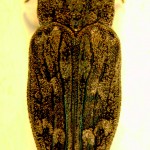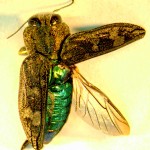Many insects feed and make their homes in the bark, trunks and branches of shade trees and shrubs. Borers belong to several different insect groups, including a variety of beetles, moths and horntail wasps.
Most insect borers are attracted to weakened, damaged, dying or dead plants. These are referred to as secondary invaders because they attack only after a plant has been weakened by another stress. (See “Metallic wood-boring beetles abundant” article below.) Secondary invaders are a symptom of other problems with the health of the tree or shrub, but may contribute to its decline. Secondary invaders include species from groups already mentioned, but also may include termites, carpenter bees and carpenter ants.
In the adult stage, they are also known as metallic wood-boring beetles. There are probably several species involved. Some of these are very attractive, large species prized in insect collections, such as Plinthocoelium suaveolens plicatum (Leconte) on Bumelia langinosa (Gum bumelia). Larval stages of these beetles (Cerambycidae) are called roundheaded borers.
Watch a video of the green longhorned beetle.
Metallic wood-boring beetles abundant on stressed and dying Texas trees in 2012
With so many trees stressed and dying from last year’s record-setting drought, it is no wonder that the bark-boring beetle complex is having a field day/month/ year! Stressed and dying oak trees in particular are crawling with fast-moving and easily disturbed, strong-flying beetles. Ed Riley, Associate Curator of the Texas A&M Insect Museum identified these as Chrysobothris species on oaks. These are insects in the insect order Coleoptera and beetle family Buprestidae.
Adult females lay eggs in and on bark and eggs hatch into larvae called flatheaded borers that feed between the bark and the heart wood, disrupting sap flow. They can additionally stress trees and occasionally cause tree death. The adult beetles are attracted to stressed and dying trees. These species are unlikely to be primary invaders that attack healthy trees.
Heavy beetle activity has been observed since late April through May 2012 on weakened oak trees throughout Central Texas. Numerous requests have been received from people wanting to know if treatments are warranted. The answer is: certainly there are treatments (bark sprays) that could be applied and that these will kill a lot of adult beetles (see Publication B-5086), but they may do nothing to save the health of a tree that is already stressed and may be dying anyway.



